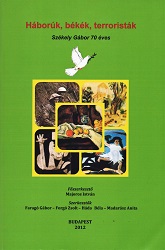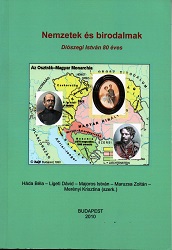
Five Continents
ÖT KONTINENS
The journal publishes studies about the history of the 18-21 centuries in English, French and German. But sometimes there are studies in Italian, Russian and Hungarian too.
More...
The journal publishes studies about the history of the 18-21 centuries in English, French and German. But sometimes there are studies in Italian, Russian and Hungarian too.
More...
Keywords: War; conflicts; Postcards; Great Powers; Austro-Hungarian Monarchy; Serbia; Sarajevo;
Eötvös Loránd University has taken a conference of two-days for the Centenary of the First World War in 2014 (8-9 May). This book contains the texts of this conference, 53 studies.
More...
Keywords: András Balogh; ambassador; public activity; professor; India; Thailand;
Professor András Balogh had Seventy years old in 2014. His department published a volume for his birthday. This book contains the studies of his colleagues (47).
More...
Keywords: War; peace; terrorist; diplomacy; globalisation; conflict; European Union; Hungary; colonisation; Soviet Union; USA; marxism;
This book made for the seventieth birthday of Gábor Székely, Professor at the Eötvös Loránd University of Budapest, contains 51 studies. His colleagues wish him Happy Birthday.
More...
Keywords: Nation; empires; Austro-Hungarian Monarchy; Great Powers; Hungary; Central Europe; democracy; risorgimento; Eastern Academy;
This book has been published as Festschrift on the occasion of the eightieth anniversary of Professor István Diószegi. 47 of his colleagues have contributed studies to this book dealing with the manifold questions István Diószegi has raised regarding the history of the 19th and 20th centuries.
More...
Keywords: Everyday life; food revolution; French kitchen; epidemics; women; emancipation of women; healing; leisure time;
This book presents the everyday life in the 19th century, in Europe. The author goes back to ancient times, to medieval age to present the changes of the everyday life. In the first chapter he deals with the food situation in Europe and the food revolution in the second part of the 19th century. The author presents the epidemics from the ancient time to the end of the 19th century and he deals with the healing and the drugs too. The book presents the situation and the changes in the life of the women. The last chapter presents the leisure time situation in Europe.
More...
Keywords: Revolution; War; Hungary; Austro-Hungarian Monarchy; Russia; India; Iran; Pakistan; liberalism; constitution; Napoleon I; Second World War; racial theory; Budapest; János Bottyán; Paris;
Sándor Vadász was 80 years old in 2010. His colleagues greeted him with studies. At the end of the volume there is an interview with professor Vadász about his life.
More...
Keywords: Hungary; USA; Russia; Black Sea; Garibaldi; John Adams; Batthyány; European Union; Hollywood; Tisza István; Kölcsey; Hungarian language;
The volume includes studies for Urban Aladár's birthday. The professor deals with the American history and with Hungary in the 19th century, first of all with the revolution in 1848-1849. The colleagues of professor Urban from ELTE and from the other universities and instituts in Hungary have wroten various studies from the Hungarian and the world history of the 19th and 20 centuries to the respect of Aladár Urbán.
More...
Keywords: Central Europe; portraits; European Thinker; Milan Kundera; politicians; writer; Trianon; Economist; Austro-Hungarian Monarchy;
This book presents 27 portraits from Central Europe of 20th century. What is Central Europe? It's not easy to determine it. This region was always in the crossfire of dispute. Central Europe resembles Egyptian dying and rising gods, but the region exists and it has given many distinguished personalities to Europe and the World. The book presents this richness.
More...
Keywords: Arab world; Arab-Israeli War; Cold War; Hungarian-Egyptian relations; Arabic literature; Arab-Hungarian relations; Houthi movement; Gulf countries; Meghreb; Diplomacy; Arab-European peace; Arab modern history; Arab Cinema ;
The lexicon is divided into four chapters. The first one is a detailed introduction, where we present a professional background of our topic, the significance of our research, the structure of our work, as well as the used literature and sources, in addition to an overview of the Arab-Hungarian relations. In the second and longest chapter, we portray biographies of the Arab personalities. In the third one, we examine the most important historical events in the Arab world, such as the Arab-Israeli wars, the nationalization of the Suez Canal, and the parallel crisis of 1956. In the last chapter, we briefly introduce concepts related to the stories and biographies found in the volume.Only a few results of Arabic historiography have been integrated into modern Hungarian research. Therefore, we consider it a priority to fill this gap. The aim of this work is to create a lexicon in which we gather – in the form of articles – the most eminent Arab personalities (approximately 1000), who were/are decisive in political, economic, military or even cultural life and others associated with the Arab world.
More...